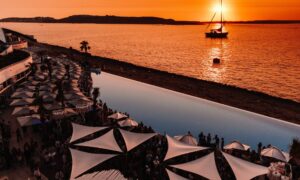Morocco opens the gateway to the Arab world, impressing its guests with the diversity of nature, the fragrance of spices, the richness of history and culture. In this country, you can fully experience the atmosphere of the Arab region.
Who goes to Morocco and why
Morocco will appeal to connoisseurs of ancient and beautiful architecture. There are beautiful palaces, religious buildings, as well as fortresses, and defensive structures. Particular attention should be paid to the ancient cities of Volubilis and Ait Ben-Haddou, which will take you back to the time of the ancient Romans.
Those who like to explore the natural sights, too, should visit Morocco. One of the most popular places is the Pillars of Hercules. These are two rocks with the Strait of Gibraltar running between them. Look also at Erg Chebbi, the sand dunes that are in constant motion and change their shape.
Take a break from the hustle and bustle and admire the rare animals in the national parks of Souss-Massa and Ifrane. The picturesque Todra Gorge and the Paradise Valley at the foot of the mountains are also worth a visit.
Cultural attractions
Jeema el-Fna Square
This is the central square of Marrakech, the largest city in Morocco, which is also called the square of severed heads. In the 10th century, it was the site of executions of criminals and brigands.
Today, Djema el-Fna is a kind of city within a city: spice shops, fruit and herbs trade, vans selling orange juice are everywhere, and tourists are entertained by cobra tamers and watermen in colorful traditional costumes, with which you can take pictures.
Hassan II Mosque
The mosque, which is the main attraction of Casablanca, was built at the end of the last century. King Hassan II laid the first stone in its foundation. In fact, it is an entire architectural complex of 9 hectares, which includes not only the buildings but also the surrounding area.
The height of the mosque is 210 m, and in the upper tier of the minaret, there is a laser projector that in the evening shines in the direction of Mecca. Inside the building, you will see huge Italian crystal chandeliers – each weighing 50 tons.
Dar Said Museum
The Dar Si Said Museum is housed in a luxurious palace in Marrakech built by Si Said bin Moussa. The exhibition includes archaeological finds and even elements of architecture.
There are collections of carpets, clothes, ceramics, weapons and other exhibits made by local craftsmen. There is also a room with jewelry and household items, cooking utensils and traditional Uzguita costumes. Tours por Marruecos
Cathedral
The temple was built in 1930, when Morocco was under French rule. The building is made of cast concrete and displays a mix of styles: Moroccan, Muslim, and neo-Gothic.
The facade is decorated with two towers resembling minarets. Today the cathedral is used as a cultural center – various fairs, exhibitions, and other events are held there.
Mausoleum of Mohammed V
The mausoleum is part of a memorial complex, including a mosque and a museum, which is located in Rabat. Sultan Mohammed V ruled Morocco in the twentieth century and became the country’s first king after liberation from French rule. The mausoleum is in Moorish style and is built of white marble.
The interior decoration is strikingly luxurious: the walls are decorated with Moroccan mosaics and the cedar ceiling is decorated with gilding and carvings.
Medina Tetouan
It is the smallest but most picturesque and beautiful Medina in the country, which is almost undestroyed.
Here you will find many Andalusian-style houses with courtyards and elegant mansions framed by columns and graceful arcades. The buildings are decorated with mosaics and ornaments, wooden panels, and plaster stucco. There are also a number of bazaars and cozy stores in Medina. viaje a Marruecos
Rabat Archaeological Museum
In the capital of Morocco, there is an archaeological museum with ancient exhibits and artifacts. The building has several halls with exhibitions of different eras: the Paleolithic, the Roman Empire, and the pre-Islamic period.
Most of the exhibits were found during archaeological investigations. A very popular collection of bronze sculptures among tourists, especially the statue of Efeb and the ivy-covered sculpture.
Nature and Parks
Menard Gardens
The most famous park in Marrakech is located near the Atlas Mountains. The gardens were created in the 12th century and cover an area of 100 hectares. Here you can stroll through the olive grove or relax in the shade of palm trees and fruit trees, or you can think your own thoughts while sitting in the gazebo and looking at the pool with colorful fish. Tourists love to come here to walk around and take beautiful pictures.
Hercules’ Pillars gerkulesovi stolbi.
One of Morocco’s main natural attractions is the two cliffs between which the Strait of Gibraltar carries its waters.
According to legend, they have formed thanks to Hercules, who mapped out the final point of his travels, which became a landmark for all sea travelers. Using the power granted to him by the gods, the hero broke through the mountain – and thus the strait and the rocks appeared. They are surrounded by deep caves where souvenirs are sold, but they fill up with water at high tide. Marrakech Desert tours
Ifran National Park
The national park in the Atlas Mountains is the main reservoir of drinking water in the country. It is also home to Mediterranean oak and cedar forests, where many birds – about 200 species – nest.
It is also home to various animals, in particular the Berber macaque, a very rare species. The pride of the park is the cedar forest (the largest in Morocco), which is excellent for picnics and hiking. In winter, Ifrane Park turns into a base for skiing.
The Valley of Paradise raiska dolina
The picturesque valley stretches at the foot of the High Atlas Mountains, a land historically owned by Berbers who still farm the slopes of the mountains today.
The valley is also called the Honey Way because of the production of cactus, lavender, orange, and other types of honey. There is also a waterfall that flows into a lake overgrown with olive trees. You can swim in the lake by jumping into the water from the surrounding rocks.
Todra Gorge
The gorge is part of the canyon, which appeared due to the rivers Dades and Todra. The distance between the rocks in some places reaches 10 m, and the height of the cliffs is 160 m. Climbers often come here, and there are hiking trails for less prepared tourists.
The view of the canyon, as if cut in two by the river, is simply breathtaking. At the base of Todra Gorge, there is a creek that used to be a full-flowing ice river.
Erg Chebbi
Not far from Erfoud there is a huge expanse of sand. Erg Shegbi is constantly in motion, so every day changes and creates a new, unique landscape. The locals call this place a punishment of the gods.
According to legend, once upon a time, tired travelers knocked on the door of the house of a wealthy family and asked to spend the night. But the owners refused them, which angered the god. As punishment, he covered their house with a lot of sand. Gradually the sand drifts were blown away by the wind and the result was the beautiful dunes. 3 days tour from Marrakech to Merzouga.
Souss-Massa National Park
nac park cuc massa
The park near Oualidia owes its name to two rivers, the Sousse and the Massa, which flow into the Atlantic Ocean.
The park covers 130,000 hectares and is home to many rare species of animals and water birds such as antelopes, flamingos, Egyptian mongooses, cormorants, etc. There are also rare species of fauna, such as mountain chana. The landscape of the park is quite varied: you can see sand dunes, bare rocks, and picturesque farms.
Remarkable buildings
The Fortress of Agadir
The fortress, built in the 16th century, is located in Agadir on a high hill, from where it is already visible at the entrance to the city. A strong earthquake in 1960 left only the ruins of the fortress.
Only the long wall surrounding the compound and the gateway remain. The ruins are beautifully illuminated in the evening and the observation deck of the remaining fortress wall offers a spectacular view of Agadir.
Bahia Palace
Built-in the 19th century, the Bahia Palace (which means “palace of the beautiful”) is located in the Medina of Marrakech. It is of Moorish style and covers an area of 8 hectares. The palace was built for one of the four wives of the Vizier Sidi Moussa. The rooms inside are arranged on the principle of a labyrinth without a strict layout.
The ceilings of Bahia were decorated with paintings and the doors were made of cedarwood. In the courtyard among the hedges and shady alleys, fountains were installed. Alas, only the ruins of this magnificent building survived.
Ait Ben-Hadu
An ancient town was built to guard the caravan routes. It is a typical representative of Moroccan architecture – all the houses look the same. They are built of clay and painted in the color of the hot sun.
Ait Ben-Haddou is truly impressive: an 11th-century fortress with red walls on a hill and an emerald-colored date oasis creates a sense of another reality. Many films have been shot in this city. It is also included in the list of UNESCO. There are souvenir stores, museums, and a mosque in the streets of Ait Ben Haddou.
Volubilis
An ancient city founded in the III century BC, it was the capital of Mauritania, as well as an outpost of the ancient Romans. Many constructions were erected to decorate the city and were characterized by refinement and elegance: various pedestals, a triumphal arch.
The ruins of the ancient city are considered to be the most beautiful in the country. The columns of the basilica and the capitol, the arch, the forum courts as well as the floor mosaics made of marble, terracotta, and smalt in the houses of the noble Romans have survived.
El Badi Palace
In the Medina of Marrakech, there is a unique piece of Maghreb architecture, the luxurious El Badi Palace, built in the 16th-17th centuries. It was built for Sultan Ahmad al-Mansour and symbolized his victory over the Portuguese army at the Battle of the Three Kings.
The building was decorated with crystal, turquoise, marble, and gold. Today, however, only ruins remain of the sumptuous palace, its courtyard overgrown with grass. The tower has an observation deck with a spectacular view.
kasba Oudaia
On the Atlantic coast in Rabat, the fortress of the Kasbah Udaya, named after the Udaya tribe (members of this tribe who lived here before the Arabs), is located. The structure was built in the 12th century.
The fortress gate is an architectural masterpiece of the pre-Arabic period. Behind it there is an inner courtyard with lots of greenery, orange groves, and narrow streets with residential houses made of shell rock. There is also a museum of Moroccan art, a café, a mosque, and an observation deck within the fortress.
Bab-Agnau Gate
Through the Bab-Agnau Gate, you can enter the Medina of Marrakech. It is an example of Islamic traditional architecture built in the 12th century. At that time, the gate was used as a ceremonial entrance to the fortified government quarter.
The construction consists of several arches passing each other. They are built in the form of a horseshoe and are decorated with Arabian ornaments. The gate looks solemn and ornate because of the bluish limestone used in its construction.



































